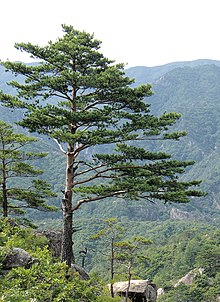**Botanical Information**:
– Pine trees are evergreen, coniferous resinous trees that can grow between 3–80 meters tall.
– Majority of pine species reach heights of 15–45 meters, with the tallest known pine being an 81.8 meters tall ponderosa pine in Oregon.
– Pines have a long lifespan, with some specimens reaching ages of 100–1,000 years.
– Pines have four types of leaves: seed leaves, juvenile leaves, scale leaves, and needles, which persist for 1.5–40 years depending on the species.
– Pines are monoecious, having male and female cones on the same tree, with seeds mostly dispersed by wind.
**Ecology and Wildlife**:
– Pines grow in diverse environments from deserts to rainforests, thriving in mountainous areas with suitable soils and water.
– Some pine species require fire for regeneration.
– Pine trees help in removing carbon dioxide from the atmosphere.
– Pine needles are consumed by various wildlife, including Lepidoptera species, birds, mammals, and insects.
– Pine nuts are a food source for birds like grouse, woodpeckers, squirrels, and are consumed by humans as well.
**Commercial and Utilitarian Uses**:
– Pines are commercially valuable for timber and wood pulp, used in carpentry, furniture, and flooring.
– Pine resin is a source of turpentine, and pine wood requires treatment for outdoor use.
– Pines are grown in plantations for harvesting after 25 years, with thinning operations conducted every 5-10 years to promote growth.
– Pine needles are used in handicrafts for decorative and practical purposes.
– Pine resin essential oils have antimicrobial, insecticidal, and antioxidant activities.
**Cultural and Artistic Significance**:
– Pines have historical significance in literature, art, and religious texts, symbolizing beauty and sanctity.
– In Chinese culture, pines symbolize longevity and steadfastness, often paired with cypress trees or considered part of the ‘Three Friends of Winter.’
– Pines are a recurring theme in literature, symbolizing resilience and beauty, and celebrated for their enduring nature.
– Pines are frequently featured in various art forms like painting, drawing, and photography, symbolizing themes of strength and beauty.
– Pine trees have been depicted as symbols of nature’s strength and beauty in various artistic creations.
**Research and Management**:
– Research on pine trees includes phylogenetic relationships, ecological analyses, and the impact of pine plantations on carbon stocks.
– Pine trees are listed in the Global Invasive Species Database, with practices like thinning to improve timber being common.
– Pine trees are used for timber production, decorating, and pulp production, with various applications of pine resin and needles.
– Literature and cultural references often feature pines, symbolizing different meanings like resilience and beauty.
– Botanical references and classifications provide detailed information on pine species and their ecological significance.
A pine is any conifer tree or shrub in the genus Pinus (/ˈpaɪnuːs/) of the family Pinaceae. Pinus is the sole genus in the subfamily Pinoideae.
| Pine Temporal range:
| |
|---|---|

| |
| Pinus densiflora (Korean red pine), North Korea | |
| Scientific classification | |
| Kingdom: | Plantae |
| Clade: | Tracheophytes |
| Clade: | Gymnospermae |
| Division: | Pinophyta |
| Class: | Pinopsida |
| Order: | Pinales |
| Family: | Pinaceae |
| Subfamily: | Pinoideae |
| Genus: | Pinus L. |
| Type species | |
| Pinus sylvestris | |
| Subgenera | |
|
See List of Pinus species for complete taxonomy to species level. See list of pines by region for list of species by geographic distribution. | |

| |
| Range of Pinus | |
| Synonyms | |
| |
World Flora Online, created by the Royal Botanic Gardens, Kew, and Missouri Botanical Garden, accepts 187 species names of pines as current, together with more synonyms. The American Conifer Society (ACS) and the Royal Horticultural Society accept 121 species.
Pines are commonly found in the Northern Hemisphere.
Pine may also refer to the lumber derived from pine trees; it is one of the more extensively used types of lumber. The pine family is the largest conifer family, and there are currently 818 named cultivars (or trinomials) recognized by the ACS. It is also a well-known type of Christmas tree.
